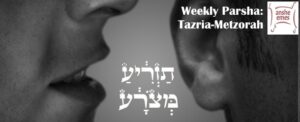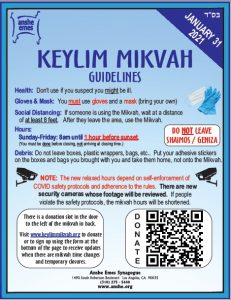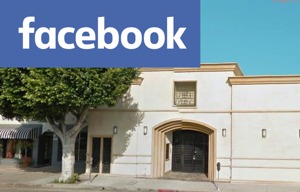
Tazria/Metzorah
I. Summary
A. The Mother of a Newborn. After giving birth to a child, a mother was not permitted to enter the Sanctuary for a specified period, at the termination of which she brought burnt and sin offerings to the Sanctuary and was then considered ritually clean once again.
B. Tzora’as. Anyone who contacts the disease of Tzora’as (similar to leprosy) was not allowed to enter the Sanctuary. Consequently, when one’s skin color indicated that he might have the disease, he was examined by the Priest. If the Kohein, after scrutinizing the person’s skin, was unable to give a definitive diagnosis regarding the Tzora’as, the person was put in isolation for seven days, and then re-examined. If the appearance of the skin remained unchanged, he was confined for an additional seven days. Then, a final examination was conducted. If the mark had still not spread, the person was declared ritually clean. On the other hand, if the blemish had spread, the person was declared a metzorah, a person afflicted with Tzora’as. He was then sent to live outside the camp of the assembly, with his clothes torn and his hair unkempt. He was told to call out “Unclean, unclean!”, as a warning for others not to touch him. When the Tzora’as subsided, the person was again examined by a Kohein outside the camp, to ascertain whether or not the recovery was complete. The elaborate cleansing ceremony which followed took place over an eight-day period, during the first and last of which special rites were observed. Sacrifices were offered by the Priest, and both cedar wood and hyssop were used in the process of purification. The former metzorah was then pronounced a full-fledged member of the community once again. The laws of Tzora’as applied equally to a garment and to a house. If a garment showed signs of Tzora’as, depending on the situation, it might be burned. If a house suddenly became marked by green or red streaks, it was boarded up for seven days. If the streaks then spread, the affected stones of the house were removed and replaced with new ones. The house was replastered, and the old stones and dust were thrown in a specially designated unclean area outside of the camp. If signs of Tzora’as still lingered in the walls, the whole building was demolished, and its building materials were discarded in the unclean area outside the camp. Certain physical impurities rendered a man or woman ritually cleaned, thus preventing them from entering the Sanctuary or touching or partaking of sacred articles. This state of uncleanliness was ended after the prescribed time by special purifying ceremonies.
II. Divrei Torah
A. Lil’Mode U’lilamed (Rabbi Mordechai Katz)
1. Tzora’as and Loshon Ho’rah. Chazal say that Tzora’as was a punishment meted out to those who had spoken spitefully of their fellow man. (For instance, it was with Tzora’as that Miriam was stricken after she spoke ill of Moshe.) Loshon Ho’rah (saying gossip, slander and negative things about others), then, is considered a most heinous crime. One who speaks Loshon Ho’rah by another person is, say Chazal, burdened with the other person’s sins. This may seem to be an unfair punishment for an apparently minor misdeed. After all, making a nasty comment about someone seems much less damaging then physically assaulting them. Yet, this is not necessarily true. Granted, one who has just been hurt feels a definite pain, but often the pain subsides in a short while. The disparaging remark, on the other hand, can linger on to haunt the victim for years. Loshon Ho’rah can be compared to one opening a bag of feathers. Even if one wanted to re-gather them one cannot, for they have been spread over by the wind.
2. Punishment for Loshon Ho’rah. Why do people speak Loshon Ho’rah? Some do so in the belief that, by belittling others, they themselves gain status. They don’t realize the suffering they are causing others. Perhaps if they, too, experienced belittlement, if they knew what it was like to become isolated from others, they would be more considerate of others. This is perhaps why the punishment for Loshon Ho’rah is Tzora’as. The metzorah, the one afflicted with Tzora’as, becomes, literally, an outcast. He must leave the three camps of Israel and maintain an isolated existence. He is looked down upon and avoided by others. He is considered impure. This is exactly the condition he caused the libeled person to experience. Now that he knows what it is like himself, he will (hopefully) be more careful in the future. When he avoids later opportunities to speak Loshon Ho’rah, he has learned his lesson. Hopefully, such severe punishment is not necessary for the average person to realize that Loshon Ho’rah is detrimental. Everyone should reach the conclusion that one way to a more peaceful life is to avoid Loshon Ho’rah. Rabbi Yannai once observed a peddler striding for town and chanting, “Who wants to buy the elixir of life?” Rabbi Yannai approached the peddler and asked him to reveal his secret potion to a lengthy existence. The peddler refused, and Rabbi Yannai persisted. Finally, the peddler responded, “You do not need any special potions. The key to a long, happy life is contained in your holy books, which state, ‘Who is the man who desires long life . . . Guard your tongue from evil . . .'” Rabbi Yannai turned to his companions and said, “I did not fully understand the feeling of this verse until the peddler clarified it. He brought it to my attention that avoiding Loshon Ho’rah is in itself a remedy for the torments of life. If one keeps away from speaking ill of others and from animosity and arguments, then he has a better chance of a calmer, more peaceful and longer life. That, indeed, is the elixir of life.”
B. Growth Through Torah (Rabbi Zelig Pliskin)
i. Learn from Aharon to make peace between people even at the price of distorting the truth. A person afflicted with Tzora’as was to be brought to Aharon or one of his sons. The Rabbi of Alexander noted that when people say negative things about others, they frequently rationalize it by saying that they are telling the truth. The other person has done so much wrong it is important to publicize what a bad person he is, they claim with “elevated intentions”. Although their claims might sound good at first, they cause much hatred, quarrels and pain. Therefore, the person with Tzora’as was sent to Aharon. One of his traits was that he did everything he could to make peace between people. He even exaggerated and told untruths in order to bring about peaceful relationships between people. This was the lesson that Aharon would give to the person who spoke against others. Don’t justify your harming and wronging others by claiming that you want to publicize the truth. Do all that is in your power to help people feel love for one another.
ii. Find a spiritual guide to assist you if you suffer. “And the Priest shall see him on the seventh day.” The Torah requires a Priest to be the one to make the decision about whether a person is afflicted with Tzora’as. This is because the Priest was able to advise those afflicted to check their behavior and correct their faults. They would also teach the person how to pray to Hashem for help. Moreover, the Priests themselves would pray for the person’s welfare. This is a lesson for someone who finds the Almighty has sent him affliction. Find a spiritual guide who will be able to point out ways in which you can improve yourself, give you advise on what to pray for, and pray for you. By doing so, you will gain much from your suffering.
iii. View the irritations caused by other people as a price you pay for companionship. “All the days of plague is in him . . . he shall dwell alone; outside the camp shall his dwelling be.” Chazal say that since the metzorah caused separation of friends by speaking against others, he too should be separated from others. Being all alone is a great distress. Everyone needs other people. Having people around you is the source of many benefits, but there is a price to pay. Your friends and relatives are bound to do things that irritate you (just as you are bound to do things that irritate them). If you keep in mind that the alternative to having people around is being all alone, you will view the drawbacks of having friends and relatives as a price well worth paying.
iv. Think before you speak. “And the Priest shall command to take for him who is to purify two birds alive and pure.” Rashi states that the reason birds were taken for the process of purifying the metzorah was because birds constantly chirp. Since Tzora’as comes from speaking Loshon Ho’rah, which is a matter of chattering, the metzorah needs birds for its atonement. Rabbi Yeruchem Levovitz commented on this that the Torah is giving us a key into what lies behind a person’s speaking against others. A root of the problem is that the person keeps on talking without thinking about what he is saying. Just as birds keep making noises, so too is the person just making a lot of noise. A person needs to think about the goals of what he about to say. Before speaking you should ask yourself, “What is the purpose of what I’m about to say? What will it accomplish? What effects will it have?” Once you get into the habit of asking yourself these questions, you will always think before you speak. This will enable you to overcome the tendency of speaking against others.
v. Focus on your own faults and you will not speak against others. “And the Priest shall command to take for him who is to be purified two birds alive and pure, and cedar wood, and scarlet, and hyssop.” Rashi cites the Chazal that the cedar symbolized arrogance because Tzora’as comes from arrogance. What is a cure for the person that he shall be healed? He should humble himself, which is symbolized by the scarlet that comes from the lowly worm and by the small hyssop. The Chofetz Chaim commented on this that one of the major reasons a person speaks Loshon Ho’rah is because of arrogance. Someone who speaks against others views himself as above other people and therefore feels he has a right to say negative things about them. If he were aware of his own faults and limitations, he would not seek out the faults of others. The greater your awareness of your own errors and negative traits, the less you will focus on the faults of others. When you focus on the faults of others, you gain nothing yourself. By becoming more aware of your own faults, however, you will keep improving your character and you will free yourself from speaking against others.
C. The Wellsprings of Torah (Rabbi Alexander Zusia Friedman)
i. Two ways to connect with Hashem. There are two ways in which man can be made to realize that there is a G-d in this world and that he should turn his thoughts to repentance and to higher things of the spirit. One way is through plagues and suffering, which remind man that there is a Supreme Being Who will demand strict accounting for all his deeds and to Whom he must therefore return in repentance. The other way is through Divine Grace which enlightens the eye of man so that he will be able to perceive the deeper meaning of His purpose. Such enlightenment from above comes from the performance of mitzvos and most frequently comes during the hallowed seasons, on Shabbos and on the Holidays, the Mikroei Kodesh (“Holy Consecrations”) as Scripture calls, them which summon man to commune with himself and to draw nearer to sanctity.
ii. Seeing One’s Own Faults. ” . . . and the Priest shall look at the plague . . .” Man can immediately see other’s faults, but not his own, and he finds the fault of strangers more readily than those of his own kin.
D. Peninim on the Torah (Rabbi A. L. Scheinbaum)
i. Transcending the Physical. Bearos Yitzchak suggests the following rationale for why Tzora’as was the specific form of punishment for sinful speech. Man is distinguished from all the creations by his ability to express himself through the medium of speech. In fact the term “one who speaks” is used to describe human beings. In contrast to all other creations, man’s power of speech is an inherent part of his essence. When man sins using his G-d-given power of speech, he exhibits an apparent contempt for this attribute which was granted only to him. He is, therefore, indistinguishable from an animal. This absurd view would be corrected only when he is able to clearly see the folly of his beliefs. Through the degradation of the body caused by such a debilitating illness as leprosy, man comes to reflect upon his true essence. The purpose of these plagues is not the pain which is associated with them, but rather the humiliating effect upon the individual. With the realization that the body is no more than a superficial covering for his true essence, man will mend his ways and seek true repentance.
ii. True Repentance. “All the days wherein the plague is with him, he shall be unclean.” This verse seems superfluous. Obviously, if the disease still plagues him, he is deemed unclean! The Netziv explains that one might assume that after performing the ritual of cleansing oneself and observing the rites of the metzorah, he would now be permitted to return a state of purity, even though the disease is still in him. Indeed, one is not viewed as a true baal teshuvah (penitent) until after he’s altered his previous offending habits. Superficial acts of penance, going through the external motions of performing teshuvah (repentance), are insufficient. Teshuvah begins with acknowledgment of one’s mistakes, remorse or regret for those mistakes, and definite change from one’s previous lifestyle. Thus, the Torah hereby declares that as long as the deeds remains, the repentance is not complete and the metzorah remains unclean.
E. Living each week (Rabbi Abraham Twerski)
i. Projection. “And he shall call, ‘Unclean! Unclean!'”. The literal meaning of this verse is that the metzorah was to alert people at his approach, that they did not become contaminated by contact with him. The Shelah gives this verse an additional interpretation, by inserting a comma, so that it reads “And he who is unclean calls [everyone else] unclean.” Thus interpreted, this verse supports the Talmudic statement that a person who insults others generally projects his own defects onto them (Kiddushin 70a). The Torah predated the discovery of the psychological mechanism of “projection” by thousands of years. The Baal Shem Tov elaborated on this theme, stating that the world is a mirror in whose reflection one sees one’s own image. A person with good character traits will see the good in everyone, and a person with many character defects will find fault with everyone. It is related that the Baal Shem Tov once saw a person violate the Shabbos. In keeping with his teaching, he assumed that he, too, had violated the Shabbos, or else he would not have seen this. In spite of a thorough self-searching, he could not recall having violated Shabbos, and he prayed fervently for a Divine revelation to help him realize how and when he had violated Shabbos. It was revealed to him that on one occasion he had remained silent when someone had spoken disparagingly of a Tzaddik. Inasmuch as the Zohar states that a Tzaddik has the kedushah (sanctity) of Shabbos, failure to offend the honor of the Tzaddik was tantamount to a violation of Shabbos. Some people are very critical of others who transgress the Torah commandments, and indeed it is a mitzvah to try and enlighten a person on the importance of observing its mitzvos. The Baal Shem Tov’s teaching, however, is that we must do sincere soul searching to find in what manner we ourselves have been guilty of the behavior we are criticizing in others. Just think of how wonderful the world would be if we followed this teaching of the Baal Shem Tov. Each time we were aroused to criticize the fault of another, we would turn our attention inwardly to work on self-improvement first.
ii. Blessings in Disguise. “When you enter the land of Canaan that I’m giving you as an inheritance, then I will inflict a ‘leprous’ lesion in the houses you inherit.” The tone of this verse referring to lesions in the walls of the house is totally different than that relating to lesions of the skin or garments, where the versus read “if there shall be a lesion . . .” The verse appears to be, as it were, a Divine promise. Rashi therefore quotes the Midrash which states that when the habitants of Canaan became aware of the advancing Israelites, they concealed their valuables in the recesses of their walls. In order that these hidden treasures be discovered, G-d caused lesions to appear in the walls of the houses. The homes would then have to be demolished, and the Israelites would find the hidden treasures. There are many other ways in which G-d could have provided the Israelites with riches. This particular method was to teach us that there are blessings in disguise. The first reaction to the appearance of a defect which could necessitate demolishing one’s home is one of anger and outrage. “Why is G-d doing this to me? ” When the hidden treasure is ultimately discovered, one understands that what had seemed to be a curse was actually a blessing. Sometimes a blessing that is concealed within painful wrappings eventually becomes apparent to us, but at other times we are not privileged to discover the hidden good. It requires an enormous strength of faith to accept distressful occurrences as being blessings in disguise. The Talmud tells us that the extraordinary faith of Nahum of Ganzu, who accepted that everything that happened to him with the statement, “This, too, is somehow good.” The Torah approach to acceptance of suffering is well-balanced. On the one hand, a person is not taken to account for feeling angry toward G-d during his acute pain (Bava Basra 16b). On the other hand, he is required to have faith in G-d’s benevolence. The initial human reaction of feeling angry towards whomever one holds responsible for one’s suffering is essentially a reflex response. On the other hand, by exercising faith in G-d’s absolute benevolence, one should be able to replace anger with serenity, with an acceptance of the fact that even things which appear to be evil according to our human perception are part of the Divine plan which is benign in its totality. The Midrash states that when Jacob was mourning the loss of his son, Joseph, and complained that G-d had turned away from him, G-d said, “Here I am manipulating things to make his son the viceroy of the Egyptian empire, and he is complaining!” Both aspects of the Torah approach are depicted by the Midrash: (1) even a Tzaddik of the magnitude of Jacob may complain about his suffering and (2) G-d has a design into which everything fits, even though we may not be able to see any good in it. While we may not find a hidden treasure in every building that is demolished, we should not lose sight of this extremely important aspect of Emunah (faith) and we should gather the strength from our Emunah to withstand the stresses and distresses of life.



 Visit the group and request to join.
Visit the group and request to join.
